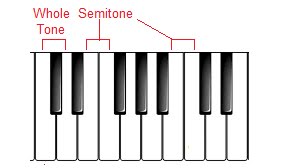Workbook (NEW for 2021) with answers HERE
Or download a printable worksheet with answersas a member of MusicOnline UKfor this lesson HERE
In Grade 1 ABRSM Theory, there are only four keys / scales that you need to know: C, G, D and F major. In Grade 1 Trinity Theory you will not need D major, but it is included in this lesson to cover all bases.
The "Key Signature" is the sharps or flats that appear in that key / scale and these are written at the beginning of the stave just after the clef sign.
Below is the scale of C major, which has no key signature.
Notice the letter S written between two pairs of notes in the above scale. These mark the "semitones" which are always between the 3rd/4th and the 7th/8th notes of any major scale as you go up. A semitone is the smallest interval or gap possible between any two notes on a piano keyboard.
So for example, the notes E and F have no black note between them, therefore, they are a semitone apart, as are B and C. On the other hand C to D is not a semitone, because there is a black note between them - C sharp. (This is actually called a whole tone, but you don't need this for a grade 1 theory exam.)
Notice too that there are no sharps or flats in the scale of C major so no key signature appears next to the clef sign.
The same is not true for G major
In order to keep the semitones between the 3rd/4th and 7th/8th notes an F sharp needed to be added, because the note immediately below G, is F sharp. Normally this F sharp is written as a key signature next to the clef sign.
Notice also how the key signature looks in the bass clef. In both cases the key signature comes after the clef, but before the time signature. It must also be remembered which line or space the key signature is written on. For example, there is an F on the top line as well as the bottom space of the treble clef. However a key signature of F sharp ALWAYS uses the top line.
Using the same rule, that semitones occur between the 3rd/4th and 7th/8th notes, the scale of D major would have an F sharp and a C sharp.
...and the key signature would look like this
Notice here how the F sharp is written just before the C sharp.









No comments:
Post a Comment
Comments with external links not accepted and WILL BE DELETED